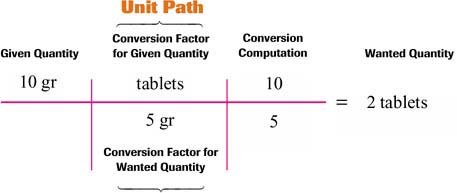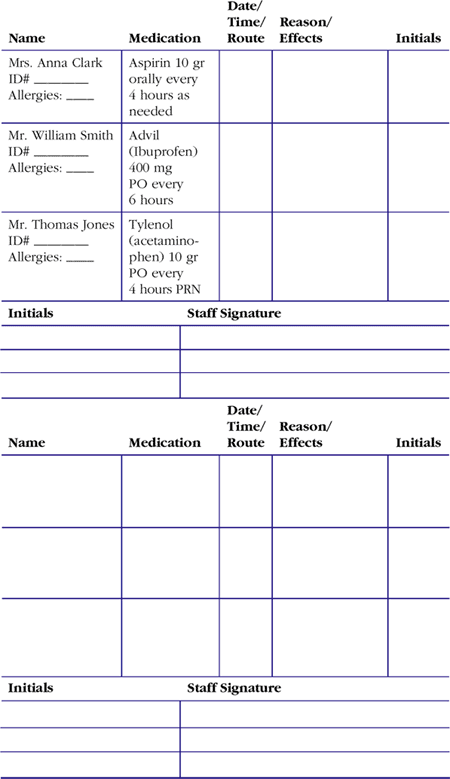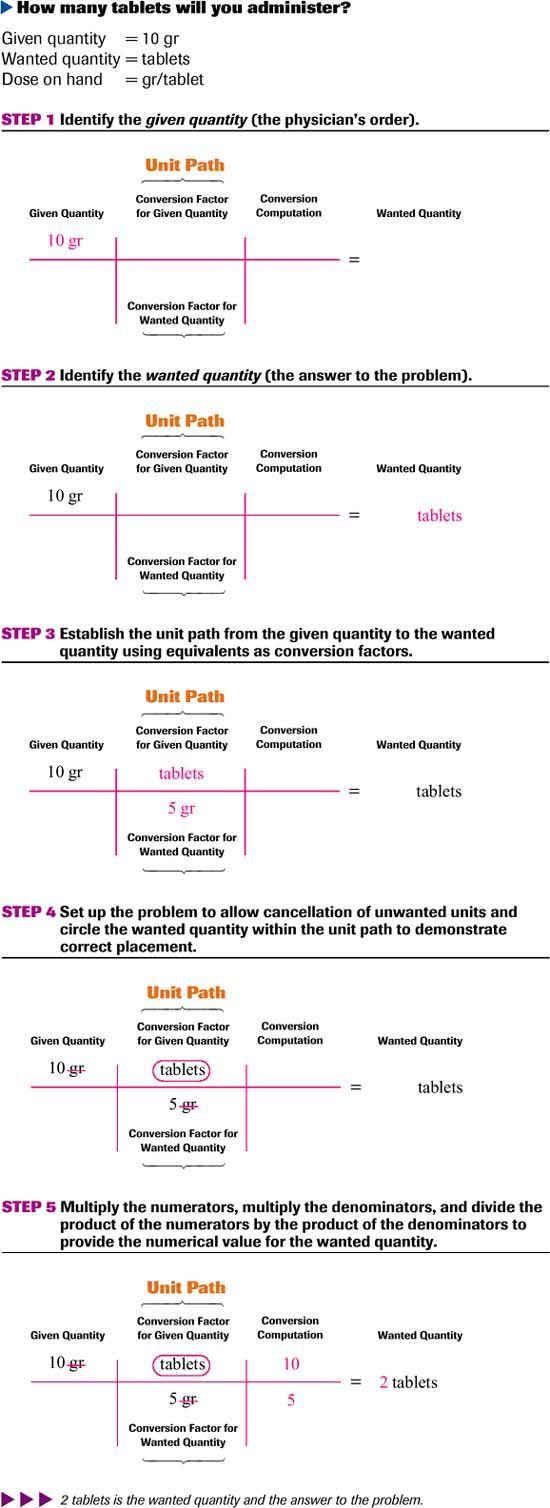One-Factor Medication Problems
Objectives
After completing this chapter, you will successfully be able to:
Interpret medication orders correctly, based on the six rights of medication administration.
Identify components from a drug label that are needed for accurate medication administration and documentation.
Describe the different routes of medication administration: tablets and capsules, liquids given by medicine cup or syringe, and parenteral injections using different types of syringes.
Calculate medication problems accurately from the one-factor–given quantity to the one-factor–wanted quantity using the sequential or random method of dimensional analysis.
 Preventing Medication Errors
Preventing Medication ErrorsFor accurate administration of medication, the six rights of medication administration form the foundation of communication between the person writing the medication order and the person reading the medication order.
The physician or nurse practitioner writes a medication order using the six rights, and the nurse administers the medication to the patient based on the six rights. There may be a slight variation in the way each person writes a medication order, but information pertaining to the six rights should be included in the medication order to ensure safe administration by the nurse and the prevention of medication errors.
To calculate the change from a one-factor-given quantity to a one- factor-wanted quantity using dimensional analysis, it is necessary to have a clear understanding of the six rights of medication administration. This chapter teaches you to interpret medication orders correctly and to calculate medication problems accurately using dimensional analysis.
Interpretation of Medication Orders
Physicians and nurse practitioners order medications using the six rights of medication administration including the:
Right patient
Right drug
Right dosage
Right route
Right time
Right documentation
Right Patient
Many medication errors can be prevented by correctly identifying the right patient. Patients in the hospital setting wear identification bands, whereas other facilities may use a photograph to identify the right patient.
Regardless of the identification method, the medication order must correspond to the identification of the patient. Checking identification and asking patients to state their names assists in reducing medication errors. It is also important to “listen” to the patient. If the patient states, “I don’t take a blue pill,” go back and check the medication order for correctness.
 Preventing Medication Errors
Preventing Medication ErrorsMedication errors can be prevented by carefully adhering to these six rights, understanding the important concepts that apply to each right, and utilizing a nursing drug reference to provide accurate information for each medication administered.
Once you are able to interpret the important components of a medication order, you can perform accurate calculations for the correct dosage using dimensional analysis. If you cannot correctly interpret the components of a medication order (illegible prescription order), call the physician or nurse practitioner for clarification to prevent medication errors.
Right Drug
Medications can be ordered using their trade name or generic name.
Examples:
Tagamet® or cimetidine
Cipro® or ciprofloxacin hydrochloride
It is the responsibility of the nurse to look up a medication before administration to ensure that the right drug is being administered.
It is the responsibility of the nurse to know the classification of the drug being administered and that the drug corresponds with the patient diagnosis. Many drugs have similar names.
Example:
Celebrex® (an anti-inflammatory)
Celexa® (an antidepressant)
It is also the responsibility of the nurse to know the side effects of the drug being administered. The nurse must be aware of any patient allergies before medication administration to ensure safety of the patient. Allergies should be clearly recorded on medication records or a patient should wear an allergy bracelet.
Because it is impossible to know all medications, the nurse can use a nursing drug reference to look up medications to ensure accuracy and prevent medication errors.
Right Dosage
Medications are available in different dosages. It is the responsibility of the nurse to ensure that the right dosage is administered. The pharmacy may supply the exact dosage ordered or the dosage may need to be converted using a common equivalent or calculated based on the weight of the patient. If the medication must be reconstituted, the correct diluent must be used for reconstitution. If a patient is to receive a tablet but has difficulty swallowing, the nurse must obtain an order to have the medication changed to an elixir. Medication orders are to be administered exactly in the dosage ordered. A nursing drug reference assists with preventing medication errors by supplying information regarding the dosages of medications that can be safely administered to a patient based on age and weight.
Right Route
Medications may be administered by different routes including oral (tablets, capsules, or liquid), parenteral (intradermal, subcutaneous, intramuscular, or intravenous), or cutaneous (skin and mucous membranes). Improper medication administration techniques (crushing an enteric-coated tablet, opening a capsule, or giving an injection using the wrong route) are considered medication errors. A nursing drug reference provides information regarding the routes that can be safely used to administer medication and eliminate medication errors. It is the responsibility of the nurse to use this information to safely administer the medication to the patient using the right route.
Right Time
Medications are ordered and need to be administered at specific times to ensure the effective absorption of the medication. Failure to administer a medication on time or failure to document the administration of a medication is a medication error of omission. Some medications are ordered before meals (ac), after meals (pc), or at bedtime. Other medications may be ordered based on frequency of time (once a day [qd], twice a day [bid], three times a day [tid], or four times a day [qid]). A nursing drug reference provides the nurse with the appropriate information to ensure that the medication is effectively and safely administered to eliminate a medication error based on adsorption. Most facilities allow a window of administration that is usually 30 minutes before or 30 minutes after the prescribed time. It is the responsibility of the nurse to use this information to safely administer the medication to the patient at the right time.
Once you are able to interpret the important components of an order for medication, you can perform accurate calculations for the correct drug dosage by using dimensional analysis.
Right Documentation
Documentation is the sixth “right of medication administration” and should be completed as soon as possible after the administration of the medication. Documentation is an important right that can prevent medication errors related to over- or under-medication. The general rule of documentation is “if you didn’t chart it… you didn’t do it” therefore medication should never be charted before administration of the medication. Documentation should follow medication administration and include documentation regarding refusals, delays, and responses (including adverse effects) of medication administration.
Exercise 4.1 Interpretation of Medication Orders (See page 105 for answers)
In the following medication orders, identify the six rights of medication administration.
Give gr 10 aspirin to Mrs. Anna Clark orally every 4 hours as needed for fever.
a.
Right patient
_____________
b.
Right drug
_____________
c.
Right dosage
_____________
d.
Right route
_____________
e.
Right time
_____________
f.
Right documentation
_____________
Administer PO to Mr. William Smith, Advil (ibuprofen) 400 mg every 6 hours for arthritis.
a.
Right patient
_____________
b.
Right drug
_____________
c.
Right dosage
_____________
d.
Right route
_____________
e.
Right time
_____________
f.
Right documentation
_____________
Tylenol (acetaminophen) gr 10 PO every 4 hours for Mr. Thomas Jones prn for headache.
a.
Right patient
_____________
b.
Right drug
_____________
c.
Right dosage
_____________
d.
Right route
_____________
e.
Right time
_____________
f.
Right documentation
_____________
Medication Administration Record
A Medication Administration Record or MAR is a document used to chart the administration of medication. In an effort to reduce medication errors related to misinterpretation of hand-writing, many health care facilities are now using an Electronic Medication Administration Record or eMAR. Documentation must occur on the MAR after the administration of a medication as well as if a medication is not administered. If a medication is not administered, the reason that the medication was not administered must also be written on the MAR. A sample MAR will provide an opportunity to practice the sixth right of medication administration using Exercise 4.2.
One-Factor Medication Problems
Medication problems can be easily solved using the five steps of dimensional analysis:
The first step in interpreting any physician’s order for medication is to identify the given quantity or the exact dosage that the physician ordered.
The second step is to identify the wanted quantity or the answer to the medication problem.
The third step is to establish the unit path from the given quantity to the wanted quantity, using equivalents as conversion factors to complete the problem. Identification of the available dosage of medicine (dose on hand) is considered part of the unit path.
The fourth step is to set up the problem to cancel out unwanted units.
The fifth step is to multiply the numerators, multiply the denominators, and divide the product of the numerators by the product of the denominators to provide the numerical value of the wanted quantity or answer to the problem.
 Preventing Medication Errors
Preventing Medication ErrorsThe given quantity is the doctor’s order and should contain all six rights of the medication order, except documentation.
You may choose to implement either the sequential method or the random method of dimensional analysis.
The sequential method of dimensional analysis requires ordering and reorganizing the conversion factors into the unit path in a logical, sequential method. The sequential method requires identification of the given quantity followed by the appropriate conversion factors to allow logical progression and cancellation toward the wanted quantity, keeping in mind correct placement for cancellation. The sequential method is based on a logical process and placement of factors into the unit path. Examples 4.1 to 4.3 demonstrate the use of the sequential method of dimensional analysis.
The random method of dimensional analysis allows for indiscriminate placement of conversion factors into the unit path in an arbitrary, random method. The random method requires identification of the given quantity and the wanted quantity but permits individualized placement of the conversion factors into the unit path. The random method focuses on the correct placement of the conversion factor (dose on hand) in the unit path to correspond with the answer (wanted quantity). If the wanted quantity is tablets, then tablets must be in the numerator position in the unit path with the dosage in the denominator position. The random method allows for canceling of conversion factors without regard to logical, sequential placement of the conversion factors. Example 4.4 demonstrates the use of the random method of dimensional analysis.
Below is an example of a one-factor problem showing the placement of components used in dimensional analysis.
 |
 Thinking it Through
Thinking it ThroughBoth 10 gr and tablets are numerators without a denominator. This is called a one-factor medication problem because the given quantity and the wanted quantity contain only numerators.
The dose on hand (5 gr/ tablet) is an equivalent that is used as a conversion factor and is factored into the unit path.
The unwanted units (gr) can be canceled from the problem leaving the wanted quantity (tablets) in the numerator.
The sequential method of dimensional analysis has been used to factor in the dose on hand, which allows the previous unit (given quantity) to be canceled. When using the sequential method, the conversion factor that is factored in always cancels out the preceding unit.
 Preventing Medication Errors
Preventing Medication ErrorsWhen preparing to administer more than two tablets or capsules to a patient, always recalculate the answer to ensure the correct answer and prevent medication errors. Rarely does a patient receive more than two tablets or capsules of a medication. If more than two tablets or capsules are being administered, a different dosage of the medication should be discussed with the pharmacist.
 Thinking it Through
Thinking it ThroughThe sequential method of dimensional analysis has been used to set up the problem. The unwanted units (mg) have been canceled from the unit path by correctly factoring in the dose on hand (200 mg/tablet). The same number of zeroes has also been canceled from the numerator and denominator.
Principles of Rounding
If an answer does not result in a whole number, but instead a decimal in the tenths (4.7) or hundredths (4.75), the answer can be rounded up or down to allow for administration of the medication. Some medications may not require rounding when the exact amount of medication calculated needs to be administered.
 Preventing Medication Errors
Preventing Medication ErrorsStay updated, free articles. Join our Telegram channel

Full access? Get Clinical Tree





